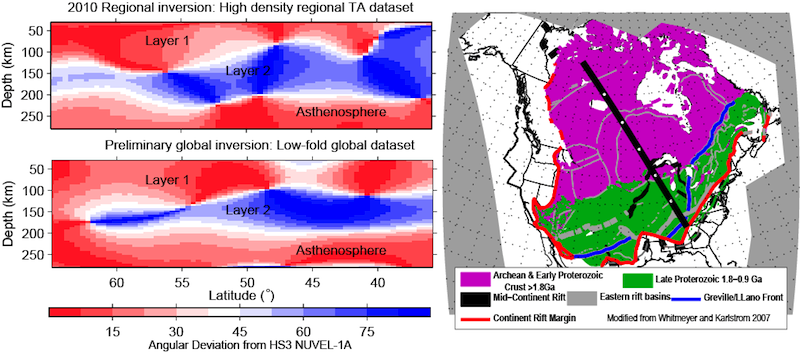2012 IRIS Workshop
Azimuthal anisotropy in the global upper mantle
Huaiyu Yuan: Berkeley Seismological Laboratory, Barbara Romanowicz: Berkeley Seismological Laboratory
Comparison of the North American depth cross section (see map to the right) for the azimuthal anisotropy fast axis directions between Yuan and Romanowicz 2010 model (top left) and the preliminary global inversion model (lower left). Plotted is the anisotropy direction difference with respect to the North American absolute motion direction in HS3 NUVEL-1A model (Gripp and Gordon 2002). Despite the global inversion currently has much lower data fold (~100,000 paths for the global compared with ~650,000 paths for the North American region in Yuan and Romanowicz 2010), and does not have the SKS splitting data incorporated, a promising three-layer anisotropy domain is observed, confirming the layering found in North America (Yuan and Romanowicz 2010).

Full-resolution graphics file in original format: 0133.png
We recently developed a new three dimensional radially and azimuthally anisotropic model of the upper mantle in north America, using a combination of long-period 3-component surface and overtone waveforms, and SKS splitting measurements ( Yuan and Romanowicz, 2010, Yuan et al., 2011). We showed that azimuthal anisotropy is a powerful tool to detect layering in the upper mantle, revealing two domains in the cratonic lithosphere, separated by a sharp laterally varying boundary in the depth range 100-150 km, which seems to coincide with the mid-lithospheric boundary (MLD) found in receiver function studies. Contrary to receiver functions, azimuthal anisotropy also detects the lithosphere-asthenosphere boundary (LAB) as manifested by a change in the fast axis direction, which becomes quasi-parallel to the absolute plate motion below ~250 km depth. A zone of stronger azimuthal anisotropy is found below the LAB both in the western US (peaking at depths of 100-150km) and in the craton (peaking at a depth of about 300 km). Here we show preliminary attempts at expanding our approach to the global scale with the goal, in particular, of determining whether our results can be generalized to other cratons. We started with our most recent global upper mantle radially anisotropic shear velocity model, determined using the Spectral Element Method (French et al., 2011) and augmenting the corresponding global dataset of initially 200 events and xxx long period waveforms, in order to ensure optimal azimuthal coverage of the globe. Depth parameterization is chosen so as to resolve the kind of layering seen in north America. Our preliminary results, which do not yet incorporate SKS splitting measurements, look promising as they confirm the layering found in North America, using a different, global dataset and starting model. References: French, S., V. Lekic, and B. Romanowicz (2011) Toward global waveform tomography with the SEM: Improving upper-mantle images, Fall
Acknoweldgements: Work supported partially by NSF/Earthscope program grant # EAR-0643060.
For further reading: Yuan, H. & Romanowicz, B., (2010), Lithospheric layering in the North American craton, Nature, 466, 1063-1068, 10.1038/nature09332. doi: 10.1038/nature09332
Keywords: surface_wave, anisotropy, lab
